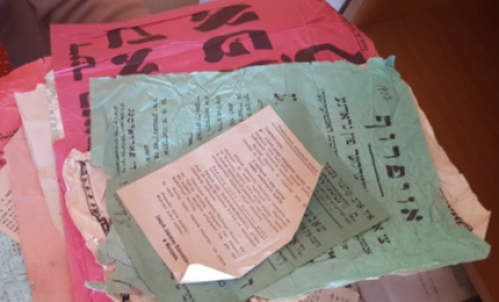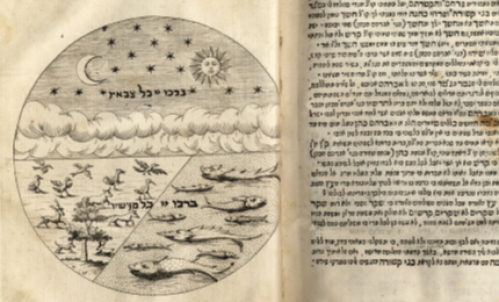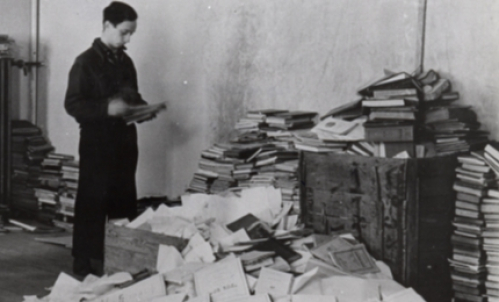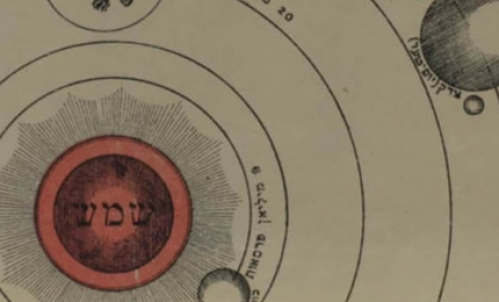An Evening in Chicago: A 1925 Photo from the Vilna Collections
by ALYSSA QUINT
Many of the thousands of photographs found in the Esther-Rokhl Kaminska Theater Collection, one of the collections being digitized for the Vilna Collections Project, are performance stills showing actors on stage sets. The collection itself was assembled in Poland, at YIVO’s original prewar headquarters.
But within the collection are also photographs that document Yiddish theater in America and even some that transcend theater history to cast light on everyday Jewish life, such as this 1925 photograph from Chicago.
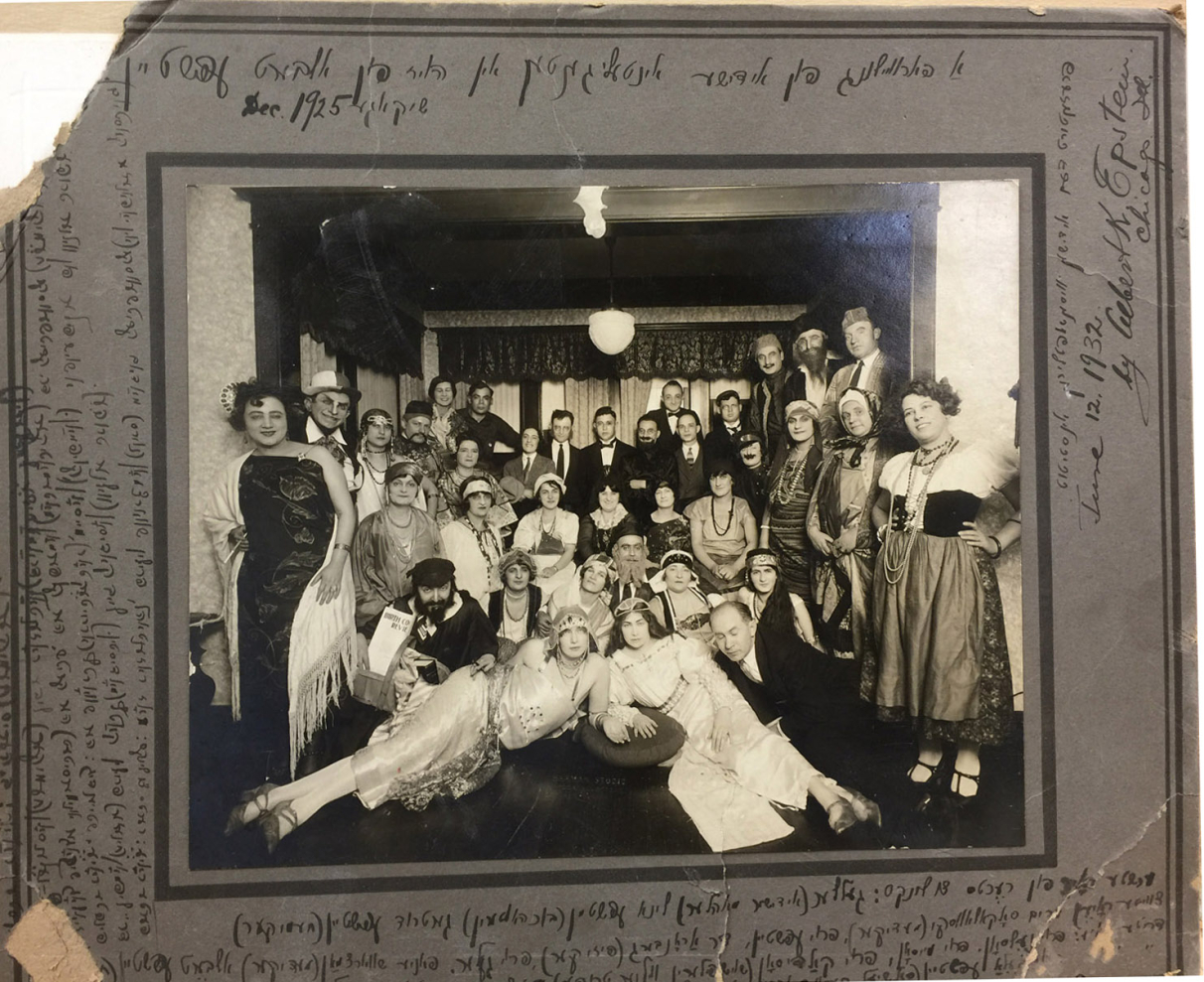
In 1932, Albert K. Epstein (1891-1948), a prominent scientist in Chicago, presented this photograph to the YIVO Institute in Vilna to preserve for posterity. Epstein began life in America as a Jewish immigrant from Poland and the photograph reflects his immersion in a very rich multi-faceted and multilingual American Jewish cultural life.
The photograph depicts a moment from a party he had thrown in his Chicago home seven years earlier. Presumably Epstein thought of YIVO as the most appropriate home for the photo because of the company he hosted that night: actors from the Vilna Troupe, among others. We have little access to what took place the rest of the evening: we have not come upon mentions of it in memoirs or articles. One can imagine the photographer from “Herman Studio” (its stamp is in the lower center of the photo) carrying the table out of the dining room to make room for his subjects, arranging the host and his guests, and then the sound and flash of the camera’s bulb.
Epstein provides some information about those in the photograph in Yiddish along its cardboard mount. He labels it “an entertaining evening in Albert K. Epstein’s House” and provides the names of many of his guests. The two women in Oriental costume with bejeweled headdresses, lying on the floor in the foreground of the photo are his daughters, Gertrude (a “chemist”) and Lena (“accountant”). Albert Epstein himself sits to their right dressed in the traditional black cap and beard of a shtetl-dwelling Jew.
We do not know that much about the Vilna Troupe’s visit to Chicago in 1925, though we know it was there as part of an overseas visit that also included a run in New York City. The Vilna Troupe, based in Poland, was a constellation of multiple companies, with a shared experimental orientation and a desire to maintain high artistic standards on the Yiddish stage. They were active from 1915-1936.
The Kaminska Collection has thousands of letters, posters, and programs that will enable scholars to research their activities and even shed light on the small mysteries presented by this photo. For instance, by the time he recorded the names on the photograph, Epstein, apparently, did not remember the names of each actor who had been in attendance seven years earlier. He labels two women in the photo simply as “actors.” Two of the Vilna Troupe actors he includes by name are not mentioned in the six-volume Encyclopedia of the Modern Yiddish Theater (Leksikon fun yidishn teatr, by far the greatest single resource about the Yiddish theater, but hardly comprehensive, especially when it comes to the theater’s female participants).
One member of the Vilna Troupe that Epstein does recall is Leib Kadison (1881-1947). He is on the far left of the photograph, dressed as a clown and wearing a hat. Kadison was originally from Kovno (Kaunas) where he painted sets and created costumes for an amateur theater troupe. Besides taking care of scenery and technical aspects of the Vilna Troupe’s production, he also directed and acted. (YIVO also has an extensive collection of Kadison’s sketches, which might provide the puzzle pieces needed to reconstruct the repertoire played in Chicago that year.)
In the front row, to the right of the Epstein daughters, is the artist and master print-maker Todros Geller (1889-1949). Geller was born in Ukraine and emigrated to Montreal before he settled in Chicago. In Chicago, he studied at the School of the Art Institute (SAIC) under George Bellows, a legendary artist and a key voice in the city’s modernist movement. Geller was not a member of the Vilna Troupe, but he did make theater sets.
What Epstein’s photo allows us to glimpse does not drop easily into any typical category of American Jewish life. This isn’t, for instance, a picture of radical politics. The party-goers are gathered in Epstein’s upper-middle-class home and the Chicago-based guests have higher degrees. They are well integrated into American life. They project a sense of comfort and confidence. But they are also not typical of the American bourgeoisie. Aside from the female actors, many of the women in the photo have higher degrees. Perhaps most concretely, inside Albert Epstein’s picnic basket, next to his leather-bound sefer or holy book, is a copy of Birth Control Review, the controversial periodical put out by birth control advocate Margaret Sanger--an ironic wink at the progressive politics of those at the gathering.
There is another complexity that doesn’t easily fit into the standard “categories” of Jewish history, in which enthusiasm for Yiddish culture is often seen as inimical to devotion to Zionism. Epstein’s deep engagement with Yiddish culture (with the Vilna Troupe and YIVO) was not to the exclusion of an active engagement with Zionist politics. He wrote a book about Chaim Weizman and a correspondence between him and Berl Katznelson is housed at YIVO. Likewise, the artist Geller’s work identifies as both Yiddish and Zionist. Both Epstein and Geller spent time in Palestine. Including papers and art work associated with Geller, YIVO has 30 archival collections that include documents related to the Jewish experience in Chicago.
